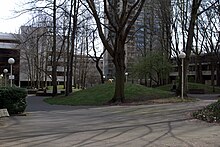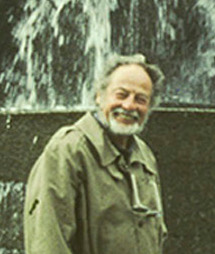
Lawrence Halprin was an American landscape architect, designer and teacher.

Governor Tom McCall Waterfront Park is a 36.59-acre (148,100 m2) park located in downtown Portland, Oregon, along the Willamette River. After the 1974 removal of Harbor Drive, a major milestone in the freeway removal movement, the park was opened to the public in 1978. The park covers 13 tax lots and is owned by the City of Portland. The park was renamed in 1984 to honor Tom McCall, the Oregon governor who pledged his support for the beautification of the west bank of the Willamette River—harkening back to the City Beautiful plans at the turn of the century which envisioned parks and greenways along the river. The park is bordered by RiverPlace to the south, the Steel Bridge to the north, Naito Parkway to the west, and Willamette River to the east. In October 2012, Waterfront Park was voted one of America's ten greatest public spaces by the American Planning Association.
Robert Murase was an American landscape architect. He worked throughout the Pacific Northwest in the field of landscape design.

Francis William Pettygrove was a pioneer and one of the founders of the cities of Portland, Oregon, and Port Townsend, Washington. Born in Maine, he re-located to the Oregon Country in 1843 to establish a store in Oregon City. Later that year he paid $50 for half of a land claim on which he and Asa Lovejoy laid out a town named Portland after the port city in Pettygrove's home state. Lovejoy preferred Boston, but Pettygrove won a coin toss giving him the right to choose the name.

Darcelle XV Plaza is a square that was a small park and fountain at the intersection of Southwest Park Avenue and Southwest Harvey Milk Street in downtown Portland, Oregon, in the United States. It received the current name in July 2023. It was named after Hugh O'Bryant, Portland's first mayor.
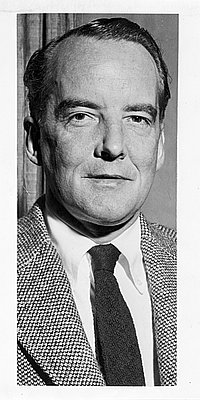
John Yeon was an American architect in Portland, Oregon, in the mid-twentieth century. He is regarded as one of the early practitioners of the Northwest Regional style of Modernism. Largely self-taught, Yeon’s wide ranging activities encompassed planning, conservation, historic preservation, art collecting, and urban activism. He was a connoisseur of objets d’art as well as landscapes, and one of Oregon’s most gifted architectural designers, even while his output was limited.

Shlomo Aronson ; November 27, 1936 – September 12, 2018) was an Israeli landscape architect. His works range from master plans for reforestation to archaeological parks and freeway planting schemes to urban plazas.
Satoru Nishita was a landscape architect and a partner in the architectural firm Lawrence Halprin & Associates, based in San Francisco. He was one of Lawrence Halprin's earliest employees, hired in 1951. He became a principal of Halprin's firm in 1964. During the period 1975 - 1977, he and several other employees bought and re-formed Halprin's as Carter Hull Nishita McCulley Baxter & Associates. The company later became Nishita & Carter, Inc. and operated through 1989.

Pioneer Courthouse Square, also known as Portland's living room, is a public space occupying a full 40,000-square-foot (3,700 m2) city block in the center of downtown Portland, Oregon, United States. Opened in 1984, the square is bounded by Southwest Morrison Street on the north, Southwest 6th Avenue on the east, Southwest Yamhill Street on the south, and Southwest Broadway on the west.

Tanner Springs Park is a city park in Portland, Oregon's Pearl District.

Director Park is a city park in Portland in the U.S. state of Oregon. Opened in 2009 at a cost of $9.5 million, it covers a 700-space underground parking garage, which connects underground to the Fox Tower and the Park Avenue West Tower. Located in downtown on Southwest Park Avenue, the nearly half-acre urban park lacks any natural areas and contains little vegetation.

Jamison Square is a city park in Portland, Oregon's Pearl District. It was the first park added to the neighborhood.

Keller Fountain Park is a city park in downtown Portland, Oregon. Originally named Forecourt Fountain or Auditorium Forecourt, the 0.92-acre (0.37 ha) park opened in 1970 across Third Avenue from what was then Civic Auditorium. In 1978, the park was renamed after Ira C. Keller, head of the Portland Development Commission (PDC) from 1958 to 1972. Civic Auditorium was renamed as Keller Auditorium in 2000, but is named in honor of Ira's son, Richard B. Keller.

Lovejoy Fountain Park is a city park in downtown Portland, Oregon, U.S.
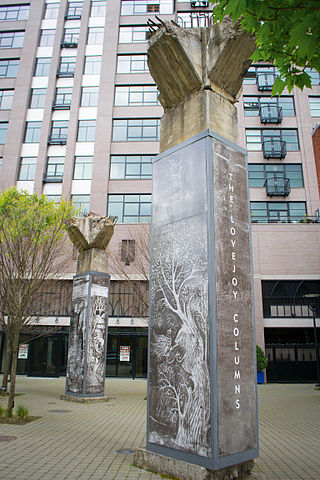
The Lovejoy Columns, located in Portland, Oregon, United States, supported the Lovejoy Ramp, a viaduct that from 1927 to 1999 carried the western approach to the Broadway Bridge over the freight tracks in what is now the Pearl District. The columns were painted by Greek immigrant Tom Stefopoulos between 1948 and 1952. In 1999, the viaduct was demolished but the columns were spared due to the efforts of the architectural group Rigga. For the next five years, attempts to restore the columns were unsuccessful and they remained in storage beneath the Fremont Bridge.

United Nations Plaza is a 2.6-acre (1.1 ha) plaza located on the former alignments of Fulton and Leavenworth Streets—in the block bounded by Market, Hyde, McAllister, and 7th Street—in the Civic Center of San Francisco, California. It is located 1⁄4 mi (0.40 km) east of City Hall and is connected to it by the Fulton Mall and Civic Center Plaza. Public transit access is provided by the BART and Muni Metro stops at the Civic Center/UN Plaza station, which has a station entrance within the plaza itself.
Angela Danadjieva is a landscape architect who founded the multidisciplinary design firm Danadjieva & Koenig Associates with her partner Thomas Koenig. She is well known for her work with Lawrence Halprin & Associates, including the Ira Keller Fountain in Portland, Oregon and Freeway Park in Seattle, Washington.

Urban Plaza, also known as the Urban Center Plaza, is a plaza on the Portland State University campus in Portland, Oregon, United States. It was designed by James Douglas "Doug" Macy and completed in March 2000.
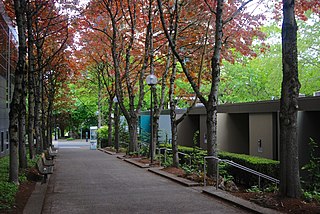
The Halprin Open Space Sequence is a series of urban open spaces and pedestrian zones between Southwest Lincoln Street and Clay Street, in downtown Portland, Oregon, United States. Designed by Lawrence Halprin, the project was completed during 1966–1970, and was added to the National Register of Historic Places on March 6, 2013. It includes Keller Fountain Park, Lovejoy Fountain Park, and Pettygrove Park, along with several other elements.

Southwest Portland is one of the sextants of Portland, Oregon.


